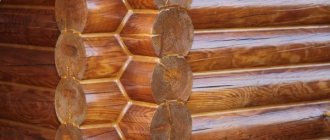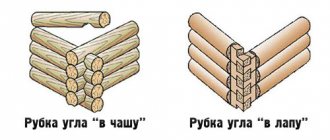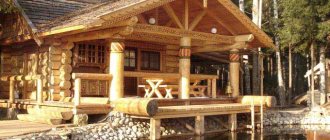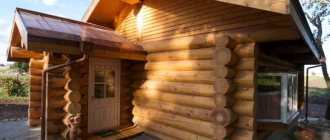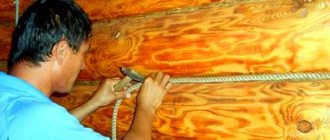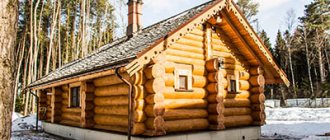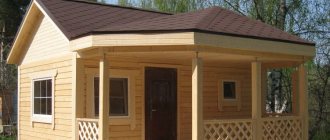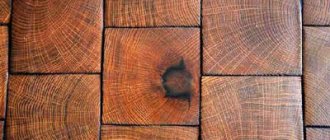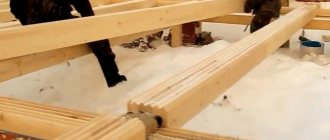Other types of foundations: COLUMNAR FOUNDATION >> | STRIP FOUNDATION >>
Basic diagram for installing screw piles under a log bathhouse. The floor joists rest on a channel 160 mm wide. Support beam instead of a channel to distribute the load on the floor joists.
1) The maximum permissible distance from pile to pile must be observed.
This distance is 3 meters. Moreover, this is primarily due to the deflection load held by the log. The permissible vertical load on the screw pile in this case has a significant margin.
2) It is necessary to support the floor joists in the center of the joist if its length exceeds 3 meters. This is done so that the floors do not “play”, that is, so that the logs do not spring under dynamic load (for example, when people walk on the floor of a bathhouse).
Since logs are cut in more often than screw piles are mounted, the central row of piles is tied with a channel. Instead of a channel, it is permissible to use a support beam (log). If a support beam is used, then the piles of the central row are twisted 15 cm lower than the other foundation piles.
3) In the places where the 5th wall inside the bathhouse frame adjoins the external walls, a pair of screw piles must be installed.
Also, when installing a foundation of screw piles under a bathhouse frame, it is necessary to take into account in which direction the floor logs will go. Typically, joists are installed so that it is possible to cut and lay floorboards, which have a standard length of 6 meters, with the least amount of waste.
We offer optimal, but not always the cheapest, installation schemes for screw piles. For example, under the frame of a 6x6 meter bathhouse, you can formally install 9 piles with heads of 20x20 cm.
We recommend making a foundation of 11 piles, 8 of which have 25x25 cm caps, reinforced with stiffening ribs, and we recommend tying the central row of piles with a channel 160 mm wide or installing a support beam (log) instead of a channel. At the same time, if you want to install an excessive number of piles in our opinion, we will warn you about this, but we will not object. If you insist on installing fewer piles than we think is optimal, we can do the installation only at your responsibility or refuse to install the foundation altogether.
The proposal for installing screw piles is valid for Moscow and regions no further than 200 km from the Moscow Ring Road. If you order a log house for a bathhouse in another region, we can recommend you a friendly organization that will install a pile-screw foundation.
To proceed to the project of a foundation on screw piles for a standard bathhouse, select the size of the log house:
| piles for a bathhouse 3x4| piles for a bathhouse 4x3+2| piles for a bathhouse 3x5| piles for a bathhouse 5x3+2| piles for a bathhouse 3x6| piles for a bathhouse 6x3+2
| piles for a bathhouse 4x4| piles for a bathhouse 4x4+2| piles for a bathhouse 4x5| piles for a bathhouse 5x4+2| piles for a bathhouse 4x6| piles for a bathhouse 6x4+2
| piles for a bathhouse 5x5| piles for a bathhouse 5x5+2| piles for a bathhouse 5x6| piles for a bathhouse 5x6+2|
| piles for a bathhouse 6x6 | piles for a bathhouse 6x6+2|
Photos of log bathhouses on screw piles. Photo galleries
To view a photo of a log bathhouse on screw piles in better quality (photo size 800x600), click on the large image. A photo of a log bathhouse on screw piles will open in a separate window. To finish viewing the enlarged photo of the log house of the bathhouse on stilts, click on the image again.
Until the recent past, log houses for baths in the Moscow and Leningrad regions were mainly installed on columnar or shallow strip foundations. Over the past five years, the technology of constructing log bathhouses on screw piles has begun to be actively introduced.
Pile-screw foundations can be considered one of the most reliable and at the same time quite cheap types of foundation. Since the log house of the bathhouse is built from whole logs, without additional joints, the lower trim crown can serve as a full-fledged grillage that combines screw piles. Therefore, for a log house it is not necessary to tie screw piles from timber or channel.
Log houses for baths are often built close to the shore of a reservoir, on a slope, including a fairly steep one (for example, on the slope of a ravine), in the floodplains of rivers and streams, where loose alluvial soils and peat bogs are common. When installing a log bathhouse in such conditions, pile-screw foundations are perhaps the only available solution.
The screw pile is immersed in the ground below the freezing level, which in the Moscow region is about 100-140 cm (in open areas cleared of snow).
During frost heaving of the soil, the bathhouse frame installed on screw piles does not rise, and when it thaws it does not fall. Log bathhouses built on pile-screw foundations do not warp, doors and windows do not wedge in them after the final shrinkage of the log house, and there are no problems with the horizontal displacement of the log house in the direction of the slope of the soil surface. When building log bathhouses on loose soils (bulk, alluvial, peat bogs, deep black soils), subsidence of the foundation under the weight of the loghouse of the bathhouse is excluded, since the blade of the screw pile is always screwed to dense soil, in which it “gets stuck”, preventing the foundation and, with it, the log house from , move vertically neither down nor up.
The price of a pile-screw foundation for a log bathhouse depends on the size of the log house, however, from the most general considerations, screw piles are cheaper than a shallow strip foundation (40 cm strip width, 60 cm depth, 40 cm base height) by about 40-50%. On slopes or when the strip foundation under a bathhouse is buried below 60 cm, savings on screw piles can be up to 100% or more.
Compared to a strip foundation, a pile-screw foundation for a bathhouse frame is installed much faster (in 1-3 days), and there is no excess soil, there is no need to dig trenches, and there is no need for trucks to drive to the construction site of the bathhouse foundation. For log houses made of logs up to 26-28 cm in diameter, it is recommended to use screw piles with a trunk diameter of 108 mm.
In this case, part of the piles is usually tied with a channel, and 250x250 mm caps, reinforced with stiffeners, are installed on the remaining screw piles. The blade of a screw pile of this diameter is 300 mm, which allows, in most cases, the installation of a pile-screw foundation under a bathhouse frame to be carried out manually, by a team consisting of 3 builders and equipped with various tools (a jackhammer, a gas drill, a wrench for tightening screw piles, etc.). d.).
The height of the base of a pile-screw foundation under a bathhouse frame is usually close to 50 cm, that is, for minor slopes, 50 cm is taken as the average value, and all piles are cut to the same level.
The minimum height of the remainder of the screw pile shaft above the ground surface is 20 cm, which is due to the need to weld the head. The maximum height of the remainder of the screw pile in the pile field under the log house of the bathhouse, which does not require tying the piles with a corrugated pipe or channel, is 80 cm. If the pile protrudes from the ground by more than 80 cm or the soil in the surface layer is loose more than 40-50 cm in depth , then it is recommended to tie the screw piles together (with a channel or prof.
pipe). Channel tying replaces the installation of headers and must be done before the construction of a log bathhouse. It is better to weld with a 20x40 mm profiled pipe after assembling the log house of the bathhouse, since during the construction of the log house the profile can be damaged (they will be stepped on or pressed by a log).
From a technological point of view, it is better not to cover the screw piles under the log bathhouse with anything in order to ensure maximum ventilation of the underground part.
With good ventilation, the lower crown will be practically not subject to rotting processes, which will allow the log house to please you for many years without the cost of repairs. If, for aesthetic reasons, you still want to close the base of the log bathhouse, then a variety of materials can be installed on screw piles: base siding, aceid, wood and even brick. To lay the base in a pile-screw foundation with brick, a channel is welded between the piles along the surface of the ground, and a 30-40 cm groove is made under the channel, into which sand is poured.
- Date: 07/14/2015 Rating: 35
Houses made of wood have been made throughout human history, and they were often installed on wooden piles. Everything new is long-forgotten old, but installing a log house on metal screw piles is a serious step forward in terms of speed, price and reliability.
Construction of a log house on a pile foundation.
A log house is a residential building made from felled, peeled and dried trees.
Most often, coniferous trees are used for felling, but no one limits the use of oak, since it is oak that provides the maximum lifespan for any structure, even in the most humid environment.
Screw piles made of metal have existed for 2 centuries, but only in the 21st were they brought to perfection. All defects were removed from the metal, optimal treatment agents against corrosion and rust were selected, the defect in loosening the soil was corrected, and at the very end, the simplest method was developed to increase strength for the entire installation period with minimal investment. Also, a serious advantage of screw piles can be considered the possibility of installation on any soil, on any type of terrain and at any time of the year, moreover, sometimes such foundations are made directly in the water, which imposes some risks, but in the end nothing affects the structure at all.
When installing houses made of round timber on screw piles, you can be sure that this approach will not only be more economical than any of the existing ones, but also the final quality will not be lower.
Return to contents
To work you will need:
Scheme of drilling wells for piles.
- Shovel. Level. Piles. Tape measure. Concrete solution m50-m100. Steel plates. Welding machine. Steel levers (crowbars are ideal for the diameter).
The process of installing screw piles requires at least 2 people, but at the very beginning you need to mark the perimeter of the future house and control points every 1.5 m. It is at the control points that the work will take place.
Externally, the piles resemble a long pipe with a drill blade at the end and 2 reinforced holes on the reverse side. When working, a water level is attached to the pipe with tape in order to constantly monitor the quality of the task being carried out.
After the starting CT has been selected, a recess of up to 30 cm is made using a shovel with a diameter depending on the blade of the pile. If the recess is not made, then the base of the pipe with the blade will constantly move from its place, which will take a lot of extra effort and time.
After the base is lowered into the resulting recess, levers are threaded into the 2 upper holes, and the workers slowly begin rotational movements. The rotation speed should not be high so that the drill cuts into the rock without damage. When moving, the drill does not loosen the soil, but compacts it, which significantly plays into the hands of the owners of the future home.
Pile driving scheme.
At the end, all piles are leveled in height, which requires any long, rigid surface (150-170 cm) with a level fixed to it. If some piles turn out a little uneven, they should be tightened or turned out a little.
A concrete solution is poured into the pipe holes. The brand does not really matter, but if the work takes place in water, then you need to take at least m100. If one day the metal fails for some reason, and there is no opportunity to replace it in the near future, then the base on concrete alone will last up to a year, even in water with a serious current.
There is no need to wait for the solution to harden, because...
this does not matter at this stage of the work. The kit includes not only screw piles, but also steel plates that serve to close the upper hole. The weld must be of such high quality that even air does not get inside.
For a house 9*10 m, 2 people prepare the foundation in 4 working days (8 hours each) from unloading them from the car to the last weld.
Return to contents
You will need:
- Steel channel. Welding machine. Reinforcing rod 8-10 mm (for pins). Grinder. Metal protection means.
Diagram of the installation of bored piles.
After the screw piles are installed and closed, you need to select a material that will combine them into one system. Most often, a metal channel is used for the grillage, but sometimes you can also find I-beams, as well as other thick-walled metal products that can perform load-bearing functions.
If they are not available from a supplier that provides screw piles (anything can happen in life), then they can be purchased at bases with rolled metal products. After welding to the foundation, they are treated with an anti-rust and corrosion compound. Welding must ideally fix absolutely every ceiling, which is done not only around the perimeter, but at the maximum number of joints, to ensure maximum strength.
You should not spare the metal, because the nominal endurance of each “support” is 25 tons, but in fact it can withstand more than 50 tons without much stress.
To connect metal to wood, 5 cm pins are welded around the perimeter of the grillage in 40 cm increments. In the wood, in turn, holes are made exactly in the places where the joints will be.
The grillage is covered with waterproofing, because it is undesirable to allow metal and wood to come into contact on a permanent basis. If everything is done efficiently, then there is no reason to be afraid, but it is better to be safe once again. The connecting pins are coated with bitumen.
Now you can install a frame of any weight on top, because the foundation will withstand everything. As a small modification, you can organize an underground floor and a simple, inconspicuous output of communications, just by covering the foundation with bricks the width of half a brick.
This type of foundation is in demand everywhere
You can quickly, economically and efficiently build a small house or bathhouse using screw piles. The construction of country houses and cottages may be planned in a wetland with a high groundwater level, with weak or heaving soils. Under such conditions, there is a need to use a pile foundation.
Reinforced concrete piles are quite expensive to use when building a log residential building or bathhouse, and you also have to use bulky pile-driving equipment. The lack of access roads to the construction site makes it impossible to deliver heavy materials and equipment to the site. In such cases, it is necessary to install the frame on screw piles.
Roof installation
We made a simple gable roof, insulated, at an angle of 45 degrees. The rafter system is made of 100x150 timber, 20 cm thick insulation, the cornices are lined with metal siding (ship plank). Covered with metal tiles.
The roof of the house is made of rounded logs.
Well, that seems to be all, in general terms he told and showed the process of building a house from rounded logs on a pile foundation. Good luck to everyone in the construction.
Photo of a general view of a house made of rounded logs.
Eco-friendly wood housing continues to gain popularity. Despite the fact that such “convenient” wooden materials for construction as timber and sandwich panels have appeared on the market, true lovers of everything natural and environmentally friendly still choose a house made of logs. Yes, they are more difficult to build. Yes, they are not always cheaper. But they are “the most real.”
The issue of choosing a foundation is very important. I want it to be strong enough. And, at the same time, I don’t want to spend too much. After all, a wooden structure is in any case lighter than a brick one.
Screw piles: advantages and disadvantages when building a bathhouse
Screw piles are made of steel pipes, which are equipped with blades and a sharp tip, with their help the structure is screwed into the ground. The tip carries the main support load, redistributes the load from the structure onto the ground, and prevents the pile from being pushed out of heaving soils in winter.
Screw piles are used as a foundation for light frame buildings, and installation of such a foundation is possible almost anywhere, even with the most inaccessible and complex terrain.
How to arrange the flooring?
In log baths, mostly wooden floors are used, less often - concrete . Wood plank flooring is installed after preliminary insulation. The work is carried out in the following sequence.
Logs are installed in the lower crowns, under which skull boards are sewn. Plates of heat-insulating material are laid between the supporting elements. A wooden sheathing is created on top of it, on which the subfloor will later be installed.
A layer of waterproofing is laid on the sheathing to prevent moisture from penetrating the underlying wooden structures. Subfloor boards are laid on top of the waterproofing layer, which are nailed or screwed to the sheathing.
Next, a cone-shaped concrete screed is constructed , in the center of which there should be a drain hole to drain moisture.
Side boards are placed around the perimeter of the room; boards cut at a slight angle are installed inside the formwork (see photo below). Next, the concrete mixture is poured.
The finishing wooden floor is subsequently laid on top of the concrete screed. In this case, the boards must be installed with a gap of several millimeters to ensure the unhindered flow of moisture through the pour-type flooring.
Before arranging the floor in the bathhouse on screw piles, it is necessary to install drain pipes in advance , which will be located under the floor covering. If you skip this stage, further arrangement of the drain will be extremely difficult.
The video will show you how to install floors in a bathhouse on screw piles:
The main advantages of screw piles:
- Ease and speed of installation - heavy special equipment is not required to install a pile foundation. The design does not require preliminary preparatory work for the installation of wells. Cost-effective - foundations for log houses made of screw piles are much cheaper than classic versions of concrete foundations. Reuse - if necessary, piles can be unscrewed from the ground and used in the construction of a new facility. Durability and stability – a pile foundation ensures high strength and stability of the building, especially with possible soil heaving in winter. Possibility of use on any soil, including water-filled, sandy, peat or clay. Use on any terrain.
Popular projects on our website
A turnkey log house on screw piles will definitely cost less than the same structure on a reinforced concrete foundation. You can order the production of piles according to an individual project, taking into account the characteristics of the terrain, or you can buy a ready-made, standard set, including connecting elements. In any case, the foundation of a log house based on screw piles is a simple and convenient solution. And given the possibility of self-installation of such a structure, which requires minimal equipment, of which the most technologically advanced would be a welding machine, such work becomes equal to the cost of the products, no more!
Our website presents a number of log house projects, for example: https://www.domastroim.ru/category/proekty-domov/proekty-srubov-domov-ploshhadyu-svyshe-200-kv-m/ Or you can see all prices for log houses . You can calculate the house or bathhouse you need with maximum accuracy using our log house cost calculator. To order and buy a log house, call:
- Vologda
- Moscow,
Disadvantages of screw piles
This is primarily due to the quality of the metal from which the structures are made, as well as compliance with the technology for protecting parts from rust. It is very important that the manufacturer carefully observes all established standards during the manufacture of structures (steel grades used; compliance with pipe wall thickness), and also carries out high-quality anti-corrosion insulation of products. Pipes immersed in the ground are negatively affected by stray currents, which accelerate metal corrosion and shorten their service life piles
Installation of piles for a log house of a bathhouse or residential building with your own hands
The pile must reach solid ground. If the length is not enough, the pile is welded.
The work will need to be carried out by two or more workers. To begin with, work is carried out on the site to remove the object into nature, for which the perimeter of the future building (residential cottage, gazebo or bathhouse) is marked out.
Measurements are taken along the length and width of the building in 1.5 meter increments, marking control points with pegs. It is at these points that the piles will be installed (screwed in).
It is very important to take the measurements correctly; the strength of the entire foundation depends on this. At control points, it is necessary to first make small depressions in the ground (up to 30 cm), which will avoid spontaneous displacement of the base of the pipe with the blade. The diameter of the holes directly depends on the diameter of the blades.
A pipe with a sharp tip is screwed into the ground with slow movements, using levers that are rotated by workers. When plunging, the drill compacts the soil, which increases the strength of the foundation.
At the end of the work, all pipes are leveled at the same level using a level; if necessary, one or more piles can be unscrewed or immersed in the ground. The pipe cavities are filled with concrete mortar of any brand.
If groundwater is located close to each other, the grade of concrete is taken to be at least M 100
Without waiting for the solution to harden, you can begin to seal the upper holes, for which special steel plates are used (included in the kit). It is very important to maintain absolute tightness when welding the top holes.
Final operations of installing a pile field
The final operations of installing screw piles include:
- Leveling. The marking begins with the corner support and is done using a laser level, the excess parts of the tops are cut off with a grinder, all technical holes for installing the gate must be cut off.
- Concreting. To protect the internal surface from corrosion, the pipes are filled with cement-sand mortar M150.
- Installation of the caps for laying the grillage; a landing cup and cap are placed on the upper edge of the support, horizontalized and welded.
- Cleaning weld seams and applying anti-corrosion coating.
